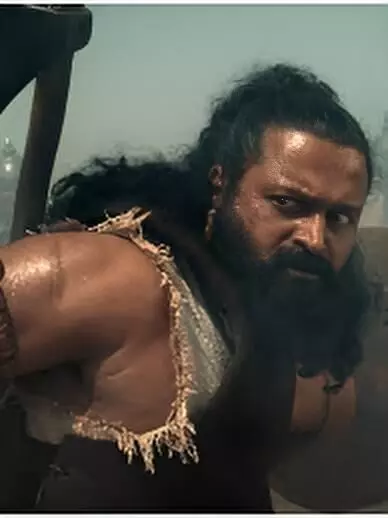Kantara Chapter 1: Exploring the Layers Beyond the Divinity of Panjurli and Guliga
Kantara Chapter 1 goes beyond Panjurli and Guliga’s divinity, exploring the Kadamba era, feudal systems, nature’s rebellion, and the spiritual evolution of Rishab Shetty’s cinematic universe.
A still from Rishab Shetty’s ‘Kantara Chapter 1’, which explores the divine world of Panjurli and Guliga while delving into history, human conflict, and the sacred bond with nature.

When Rishab Shetty’s ‘Kantara’ hit theatres in 2022, it transcended cinema to become a cultural and spiritual movement. Audiences across India described it as a film that seamlessly merged mythology, folklore, and faith. Now, three years later, ‘Kantara Chapter 1’ takes that legacy forward — delving deeper into the roots of history, social conflict, and human connection with nature. While the divine presence of Panjurli and Guliga continues to command attention, the film offers far more than mysticism.
⚔️ Reimagining History: The Feudal Era and the Kadamba Legacy
Kantara Chapter 1 portrays a world of feudal oppression and caste oppression during the backdrop of the Kadamba dynasty, one of the earliest ruling dynasties of Karnataka. With detailed world-building and immersive visuals, Rishab Shetty fashions a narrative that feels authentic and allegorical.
Forced Slavery and Social Struggle
Beyond divine elements, the film explores dark and uncomfortable truths — the forced enslavement of locals, their sale to foreign traders, and the cruel reality of untouchability. These sequences don’t just serve as historical commentary but drive the emotional core of the story. Shetty handles them with subtlety, allowing the themes to resonate without turning didactic.
Echoes of Foreign Trade
The film also shows some views of ancient trade routes and cultural exchanges along the western coast of Karnataka. Scenes of coastal merchants and travellers suggest a mixture of cultures that forged the heritage of this land. These are further historical clues added to the base narrative, which reward the observant who link both strands of history to the present.
Every frame, from costumes to architecture, art direction, and technical finesse, reinforces the authenticity of the Kadamba era.
🌿 Man vs Nature: The Eternal Conflict
At its heart, Kantara Chapter 1 re-examines the fragile relationship between humans and nature. The story begins with a hunt — but unlike the forest dwellers who hunt for sustenance, the king does so for pleasure. That difference in intent ignites the central conflict of the film.
This idea — that nature retaliates when humans overreach — echoes the theme of the first Kantara. In the 2022 film, Kishore’s Muralidhar, the forest officer, transformed from an outsider enforcing control to an ally protecting the land. The new chapter expands on that idea, suggesting that faith and reason can coexist when bound by respect for nature.
In one striking scene, a character reflects:
“We’ve already taken enough from the land and received more than we need. Why seek more?”
Lines like these underline the film’s moral — greed disrupts balance, and the cost is always paid by humanity.
🕉️ Beyond Panjurli and Guliga: Expanding the Divine Realm
The most compelling aspect of Kantara Chapter 1 lies in its spiritual expansion. While Panjurli (the boar deity) and Guliga remain central, the film introduces new divine entities and explores their mythic origins.
Panjurli’s boar form mirrors the Varaha avatar of Vishnu, symbolizing protection and the restoration of balance. A mystical tiger, said to be sent by Goddess Parvati, watches over the deities, reinforcing the sacred connection between divinity and the natural world.
The introduction of Chaundi, Guliga’s sister and an incarnation of Goddess Chamundi, further expands the lore. There’s even a fleeting yet powerful invocation of Lord Shiva, deepening the film’s spiritual texture.
🔱 Folklore, Faith, and Continuity
For fans of the original film, Kantara Chapter 1 offers a treasure trove of callbacks. The whispered legends from the first film now take centre stage, tracing the origins of the forest people, their bond with the land, and their spiritual duty to protect it.
What makes this film stand out is its refusal to be a mere prequel or commercial extension. Instead, it builds a mythic universe — layered, complex, and unapologetically rooted in the soil of coastal Karnataka.
Every visual, every chant, and every myth serves a purpose — making Kantara Chapter 1 not just a film about gods and men, but a story about balance, heritage, and the cost of forgetting where we come from.

